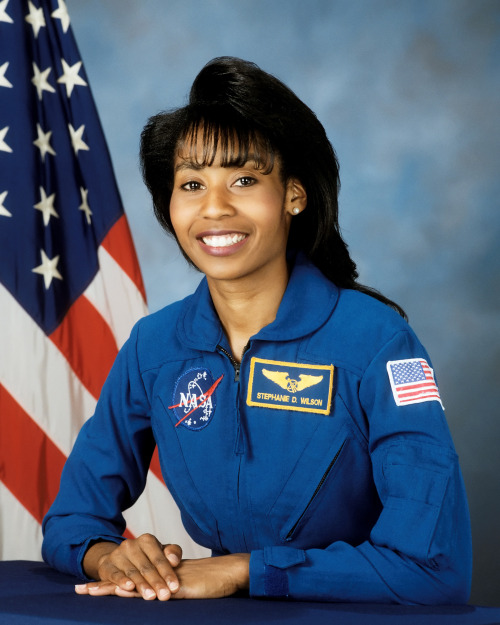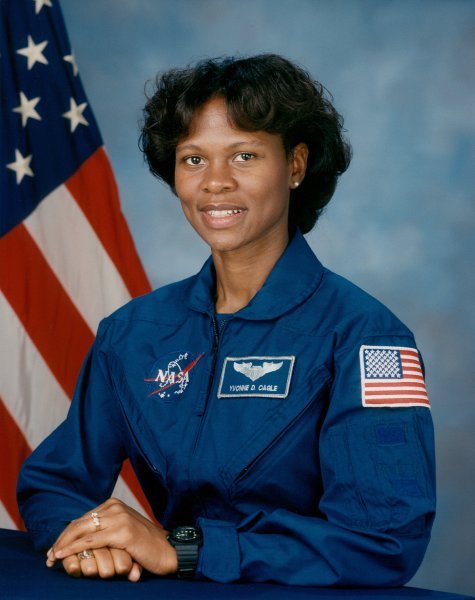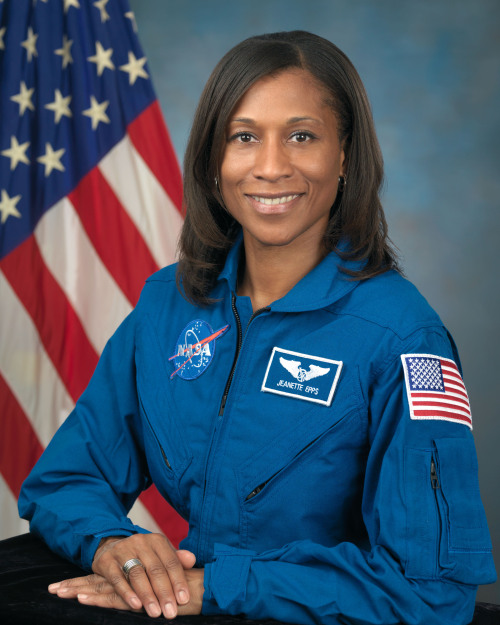A Salute To Sistas In Space





A Salute to Sistas in Space
(From top to bottom and the order in which they went into space)
Dr. Mae C. Jemison
Stephanie D. Wilson
Joan Higginbotham
Dr. Yvonne Cagle
Jeanette J. Epps
Source: 5 Black Female Astronauts You Should Know
More Posts from Curiositytherover and Others

The US space agency has just announced that it’ll be sticking four volunteers inside a tiny house for 30 days, as part of an experiment to test how isolation and “close quarters” affect people’s behaviour. Once inside, the volunteers can’t leave the cabin, and will only be able to regularly communicate with each other and NASA mission control (that means no Internet).
It sounds pretty uncomfortable, but if we want to make it further into space - all the way to Mars, for example - people are going to have to live in cramped spaces for months at a time with very little contact with the outside world, and scientists need to be able to predict the effects - including every little thing that could go wrong.
The compact, three-storey house that the volunteers will be living in is called the Human Research Exploration Analog (HERA), and it’s what NASA is calling a “science-making house”. That means there are lots of little experiments on board to keep the team occupied, like plants to grow and tiny shrimp to take care of.
Jeff Williams: Record Breaker
Astronaut becomes U.S. record holder for most cumulative time in space!
The Olympics are over, but Americans are STILL breaking records. NASA astronaut Jeff Williams just broke Scott Kelly’s record of 520 cumulative days spent in space. When Williams returns to Earth on Sept. 5, he will have racked up 534 days in space. To celebrate this amazing achievement, here are some of the best images taken during his four spaceflights.

STS-101 Atlantis:
During May 2000, Williams made his first spacewalk during space shuttle Atlantis’ STS-101 mission. On this 10-day mission, Williams’ first spacewalk lasted nearly seven hours. He is pictured here outside the space station.

Expedition 13:
Williams experienced his first long-duration mission in 2006, when he served as flight engineer for Expedition 13 space station mission. During his time in orbit, he performed two spacewalks, saw the arrival of two space shuttle missions and resumed construction of the orbiting laboratory during his six-month tour. While on one of those spacewalks, Williams took this selfie.

Expedition 21/22:
Williams returned to space for another six-month mission in 2009 as a flight engineer on Expedition 21 and commander of Expedition 22. During that time, he hosted the crews of two space shuttle missions. The U.S.-built Tranquility module and cupola were installed on station. Here is an image of the then newly installed cupola.

Expedition 47/48:
This time around, Williams has been onboard the space station since March 2016, where he served as flight engineer for Expedition 47 and now commands Expedition 48. With over 7,000 retweets on Williams’ photo of an aurora from space, his Twitter followers were clearly impressed with his photography skills.
Make sure to follow us on Tumblr for your regular dose of space: http://nasa.tumblr.com

The 7th Row of the Periodic Table is Finally Complete
And with a single announcement, millions of text books around the world have been made incomplete—out of date. This comes as four new elements are added to the periodic table, finally completing the table’s seventh row. The elements, 113, 115, 117, and 118 were discovered by scientists working in Japan, Russia, and America. Now, the International Union of Pure and Applied Chemistry (IUPAC, the body that is charged with overseeing standards in the world of chemistry) has confirmed the finds. Ultimately, these are the first elements to be added to the table since 2011. They were verified in an announcement released on Dec. 30.
Learn more: http://futurism.com/links/the-7th-row-of-periodic-table-is-finally-complete/

Finland Explores Offering a Universal Basic Income to its Citizens
The Finnish Social Insurance Institution is preparing a proposal that would provide a tax free universal basic income of €800 per month to every Finnish citizen. Read more at: http://futurism.com/links/finland-explores-offering-a-universal-basic-income-to-its-citizens/
does anyone know of any good science blogs? I want to follow more.

Is the End of Daily Insulin Injections for Diabetes Sufferers in Sight?
A new study reportedly shows that boosting the immune system can safely restore insulin production for up to a year—which might make it possible for those who suffer with diabetes to not require daily injections. Notably, these are Phase 1 trials, which are designed to look at safety, not long term effectiveness. So much research is still needed.
Yet, if the technique proves viable and effective, this could change the lives of millions of people around the world. According to the Center for Diseases Control, in the United States alone, 29.1 million people (or 9.3% of the population) have diabetes. That’s one out of every 11 people. 371 million people worldwide have this condition.
To break down the research, those afflicted with Type 1 diabetes do not have enough T-regs or ‘peacekeeping’ cells, which is ultimately what causes the disease. Researchers from Yale and University of California have just showed that T-regs can be removed from the body, increased by 1,500 in a lab setting, and then placed back into the bloodstream as a way of potentially restoring the body’s insulin production back to normal.
Find out more at: http://futurism.com/links/end-daily-insulin-injections-diabetes-sufferers-sight/

Injecting Gases Into The Stratosphere Could Reduce Hurricanes
In an attempt to combat climate change, a multinational team of scientists are studying how shading sulfate aerosols that are dispersed into the stratosphere could help cool the planet and reduce the number of hurricane occurrences. “We’re basically mimicking a volcano and saying we’re going to put 5 billion tons of sulfates a year into the atmosphere 20 kilometers high, and we’ll do that for 50 years,” says John Moore, head of China’s geoengineering research program
Read more at: Injecting Gases Into The Stratosphere Could Reduce Hurricanes
Solar System: 2015 Year in Review

Two mysterious worlds explored for the first time. Liquid water seen flowing on Mars. A global ocean discovered hiding inside a moon of Saturn. Even during our Era of audacious solar system exploration, 2015 stands out. Here are a few highlights:
1. New Horizons Reveals the Face of Pluto

Whether or not you call it a planet, Pluto entranced the people of Earth when it sent a love note from three billion miles away via our New Horizons spacecraft.
2. Dawn Comes to Ceres

The dwarf planet Ceres, the largest object in the main asteroid belt, teased explorers with its bizarre bright spots before finally giving up some of its secrets to the Dawn spacecraft. HERE are the latest findings.
3. Cassini Marks Discoveries and Milestones at Enceladus

When the Cassini spacecraft performs its final close flyby of Saturn’s icy moon Enceladus on Dec. 19, it will be a true milestone. Scientists using data from Cassini’s instruments have uncovered astounding secrets about this small moon, including (confirmed this year) the fact that its underground ocean of liquid water is global, and is home to hydrothermal vents.
4. We Confirmed Evidence that Liquid Water Flows on Today’s Mars

Findings from our Mars Reconnaissance Orbiter (MRO) provided the strongest evidence yet that liquid water flows intermittently — on present-day Mars.
5. Rosetta Passes Perihelion

The European Space Agency’s Rosetta mission had a remarkable year, re-establishing contact with the Philae lander and following comet 67P/Churyumov-Gerasimenko as it swung near the sun.
6. Mars Explorers Confirm Lakes Once Dotted Mars

A study from the team behind our Mars Science Laboratory/Curiosity Rover confirmed that Mars was once, billions of years ago, capable of storing water in lakes over an extended period of time.
7. MAVEN Finds a Culprit in the Loss of Mars’ Atmosphere

The Mars Atmosphere and Volatile Evolution (MAVEN) mission identified the process that appears to have played a key role in the transition of the Martian climate from an early, warm and wet environment that might have supported surface life to the cold, arid planet that Mars is today.
8. Akatsuki Gets a Second Chance at Venus

Five years after a mishap sent the spacecraft off course, the Japan Aerospace Exploration Agency (JAXA) successfully inserted the Venus Climate Orbiter “Akatsuki” into orbit around Venus. While the mission is not funded by NASA, an agency partnership with JAXA provides an opportunity for eight of our scientists to work with the Akatsuki team and study data from the spacecraft over the next year or so.
9. A Trailblazing Mission Sends Its Final Message from Mercury

After a flight of nearly 11 years, the highly successful MESSENGER mission ended when, as planned, the spacecraft slammed into the surface of Mercury.
10. Mars Reconnaissance Orbiter Completes 40,000 Orbits

Mars Reconnaissance Orbiter, at Mars since 2006, has orbited the Red Planet more than 40,000 times. The mission, which studies the whole planet from space, has shown that Mars is diverse and dynamic by way of many thousands of spectacular images and other kinds of data.
Make sure to follow us on Tumblr for your regular dose of space: http://nasa.tumblr.com

All city lights in Reykjavik are generated with CO2 free energy so the act had nothing to do with raising awareness of global warming. The only initiative is the fact that we are raising the first generation on earth without access to dark skies, stars and the Milkyway
-Andri Magnason
Source
Follow Ultrafacts for more facts

The God Brain: Roundtable Discussion on God and Spirituality for Brain Games
NeuroscienceNews was invited by National Geographic’s Brain Games to participate in a virtual roundtable discussion on the question:
“Is belief in God innate in our brains, as if it were installed by some divine programmer? Or is spirituality a more complex evolving adaptation that has both helped and harmed us as a species?”
Let us know what you think.
Image: Jason Silva sits with Jonathan, a grad student at IDC Herzliya as they test out the virtual reality EEG cap and goggles. Photo Credit: NG Studios/Andy Fram.
-
 annarqrqy liked this · 6 months ago
annarqrqy liked this · 6 months ago -
 littleblacksquashball liked this · 10 months ago
littleblacksquashball liked this · 10 months ago -
 artofjudycopes liked this · 1 year ago
artofjudycopes liked this · 1 year ago -
 rinaedin liked this · 2 years ago
rinaedin liked this · 2 years ago -
 promiscuous-nigerian liked this · 2 years ago
promiscuous-nigerian liked this · 2 years ago -
 deepshecreatures reblogged this · 3 years ago
deepshecreatures reblogged this · 3 years ago -
 rockymountinchick liked this · 3 years ago
rockymountinchick liked this · 3 years ago -
 berlanii2licious liked this · 3 years ago
berlanii2licious liked this · 3 years ago -
 berlanii2licious reblogged this · 3 years ago
berlanii2licious reblogged this · 3 years ago -
 xosiren reblogged this · 3 years ago
xosiren reblogged this · 3 years ago -
 xosiren liked this · 3 years ago
xosiren liked this · 3 years ago -
 iijdm reblogged this · 3 years ago
iijdm reblogged this · 3 years ago -
 sexybootyluver liked this · 4 years ago
sexybootyluver liked this · 4 years ago -
 welcometoourmind reblogged this · 4 years ago
welcometoourmind reblogged this · 4 years ago -
 dhejagreen liked this · 4 years ago
dhejagreen liked this · 4 years ago